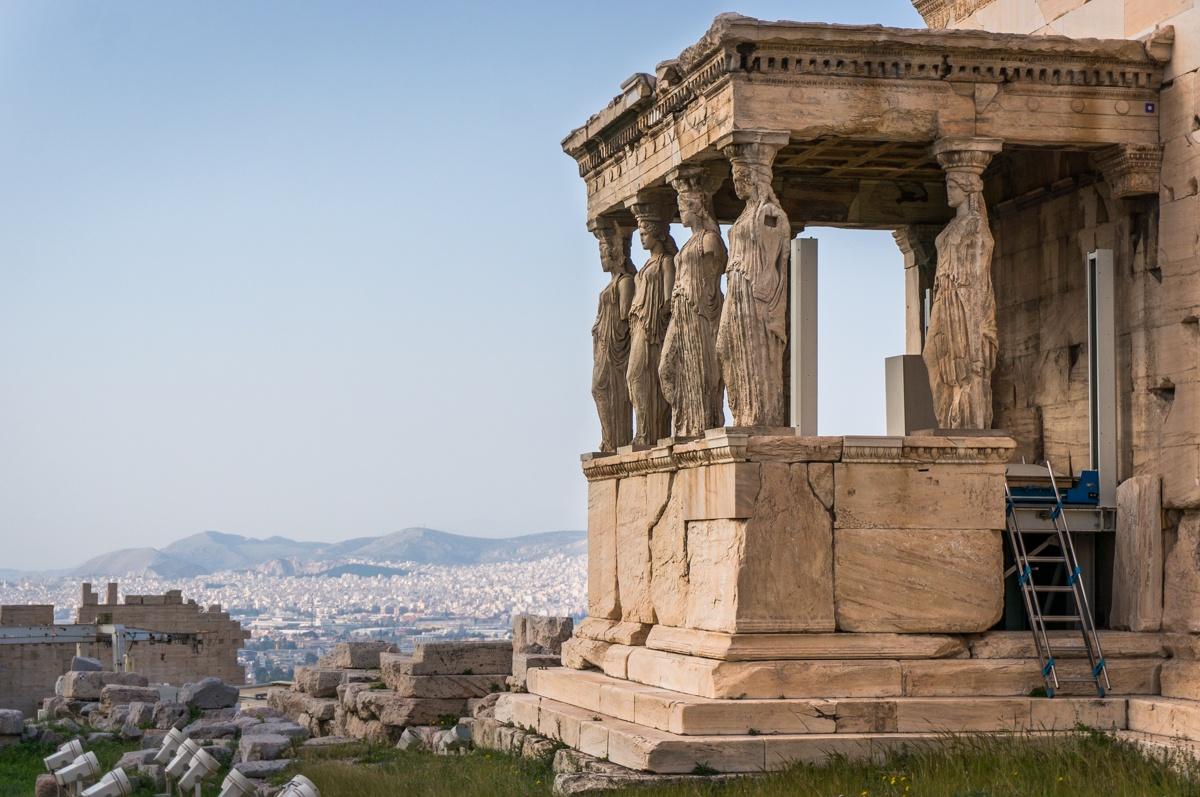
Athens Metro Guide: Routes and Insider Tips
Key Takeaways:
- The Athens Metro boasts three lines, which are known by their colors and connect to the tram, bus, and railway.
- Athens Metro runs daily from 5:30 am to 00:30 am. On Fridays and Saturdays, lines 2 and 3 operate until 2:30 am.
- A regular 90-minute single ticket for all public transport means costs €1,20.
- You can access all of the city's most significant landmarks easily by metro, such as the Acropolis and Syntagma Square.
- Inside most central Athens Metro stations, you can marvel at fascinating ancient ruins.

It took 2000 years for Athens to have a subway service running through its beautiful grounds, but it was worth the wait!
Almost 20 years ago, Athens’ Metro network came with a bang, meeting and exceeding the expectations of the locals, who have since made it part of their daily routine.
Modern, beautiful, and most importantly, efficient, the metro is one of the best ways to commute when visiting a historic city that won’t break the bank and will help you reach your destination with ease, comfort, and surprising speed! Renting a car in Greece is still a choice you can make, but not a necessary one!
We have prepared the most helpful Athens metro guide so you can explore Athens, a must-visit stop in all of our Greece vacation packages, like a local!
Athens metro lines and general info
The Athens Metro system consists of three lines, which are known most commonly by their colors and connect to the tram, bus routes, and suburban railway.
Line 1 – The green line goes all the way from Piraeus to the northern suburb of Kifissia, with its most popular stations being ‘Monastiraki,’ ‘Thissio,’ and ‘Omonia.’
Line 2 – The red line goes from Anthoupoli to Elliniko, with its most popular stations being ‘Acropolis,’ ‘Syntagma,’ ‘Panepistimio,’ and ‘Omonia.’
Line 3 – The blue line is the line that serves the Athens International Airport, passing by the ‘Syntagma' Metro station and ‘Monastiraki' station before terminating at ‘Agia Marina.’
What time does the Athens metro close?

You should keep in mind that the metro system runs daily from 5:30 am to 00:30 am. However, on Fridays and Saturdays, lines 2 and 3 operate until 2:30 to serve the party-goers!
The frequency of the metro network is, thankfully, pretty high all of the time, and specifically, during peak hours, the trains run approximately every 5 minutes; yay for that!
Athens’ Metro Tickets
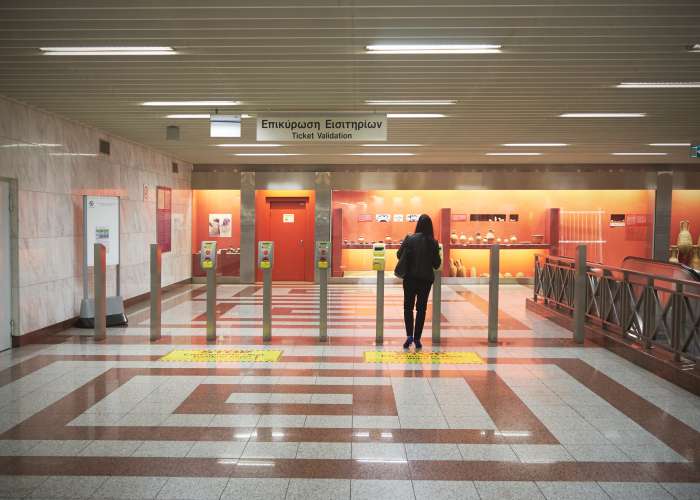
The ticketing system for Athens’ public transportation underwent a drastic revamp just a couple of years ago, bringing the city’s public transportation system to digital times.
Today, all means of public transportation in Greece have replaced the typical paper tickets that had been used for hundreds of years with electronic tickets or paper and plastic cards.
This complicated things a little bit, causing confusion even among the locals in regard to the types of tickets that are now valid and the differences between each ticket. To save you the trouble, here are the three types of tickets you can choose from once you decide to visit Athens:
The Ath.ena ticket

The Athena ticket is a paper ticket that can be used for anything from a 90-minute ticket to a 5-day ticket and is rechargeable. You can buy these tickets at any metro station or ticket office as well as in the automatic ticket machines.
It is the most straightforward of the bunch and has pretty much the same use as its predecessor. See the official site here.
The Anonymous Athena Card

The Anonymous Athena Card is a rechargeable plastic card that can be used for anything from a single 90-minute ticket to a 5-day one.
The Anonymous Athena Card is the wisest choice for travelers and visitors of Athens because it is also valid for Athens airport transfers, as well as the 3-day tourist ticket that includes Athens airport transfers anyway.
Be mindful of the fact that you cannot purchase the Anonymus Athena Card from an automatic ticket machine but only from a ticket office that you can conveniently find in every metro station. You can, however, recharge it anywhere you like - automatic ticket-issuing machines included.
The Personal Athena Card
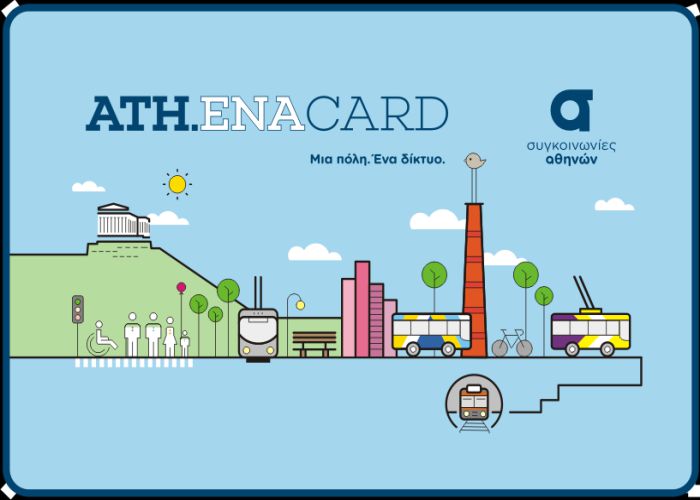 Athena card - credits: athenstransport.com
Athena card - credits: athenstransport.com
Now this one may not be ideal for you, but it is worth mentioning. The Personal Athena Card is yet again a personalized plastic card, but this time one that is geared toward people who either live or spend a big chunk of their lives in Athens.
The biggest difference in the appearance of the Personal compared to the Anonymous Athena Card is that it features your photo on it, while it can provide you with anything from a 90-minute ticket to a one-year ticket.
To issue the Personal Athena Card, you need to visit an Athens Transport Ticket office with your Greek ID card or, if you are a foreigner, with your passport.
Please note that if you are eligible for a half-price ticket, you will have to issue a Personal Athena Card. Alternatively, you can buy half-price plain Athena tickets exclusively at all suburban railway stations.
I promise it is way less complicated than it sounds! Nevertheless, if you face difficulty with anything from issuing the ticket to deciding on which one you should go for, just ask for help at one of the metro’s ticket booths, and the staff will make sure to sort you out!
How to get from the Athens airport to Athens’ city center and vice versa

Athens’ airport is connected to downtown Athens through metro line 3, or the blue line. The trip from and to the Airport to the heart of Athens takes approximately 45 minutes.
Due to popular demand, the metro departs from the airport station approximately every 30 minutes. You’ll need to get off at either the ‘Syntagma’ stop or the ‘Monastiraki’ stop. They are both equally central stops, so your choice will have to depend on your desired destination.
In order to get to the metro station -where the train station also lies- from the airport, all you need to do is follow the signs from ‘arrivals,’ which will require you to cross a road, walk up some escalators, and then finally walk across a pedestrian bridge.
Once you’ve successfully crossed the pedestrian bridge, you’ll find yourself at the train station, and this is where you’ll need to buy a ticket to pass through the barriers and down to the platforms.
To buy a ticket, you can either use one of the automatic ticket issuing machines or if, in doubt, you can also go to the kiosk and buy one in person.
Once you’re down at the platforms, you’re gonna wanna be at the platform labeled ‘Metro’ and board the train heading towards Agia Marina – Doukistis Plakentias. Again, as I said, you’ll be in the center of Athens completely hassle-free before you know it!
How to get from Piraeus port to Athens’ city center and vice versa

If you’ve reached Athens by boat and you find yourself at the port of Piraeus wanting to go to reach Athens’ city center, all you need to do is take the metro line 1 from Piraeus and disembark your carriage at ‘Monastiraki’ Station.
The terminal Metro station is just across the street from the port, and if you follow the signs, you can’t miss it! Conversely, if you’re in the city center and you need to catch the ferry to one of the magical Greek islands, simply go to the ‘Monastiraki” stop and take the metro line 1 towards Piraeus; easy peasy lemon squeezy!
How to get from the Airport to the port of Piraeus

If you can’t wait to get to the Greek Islands and the Greek capital city ain’t gonna stop you, you’ll need to go directly from the Athens airport to the port of Piraeus.
In that case, you can take the metro with direction to Agia Marina and get off at the stop of ‘Monastiraki’ station. There, you’ll need to change trains and take line 1 towards Piraeus.
Be careful, though! The train you have to change is at a different platform on a different level of the Metro station, as essentially, you’ll be changing from the underground to the overground service.
Therefore, make sure to, once again, follow the signs or, if push comes to shove, ask for help either at an ‘information’ booth or just from local passers-by.
Athens Metro Ticket cost
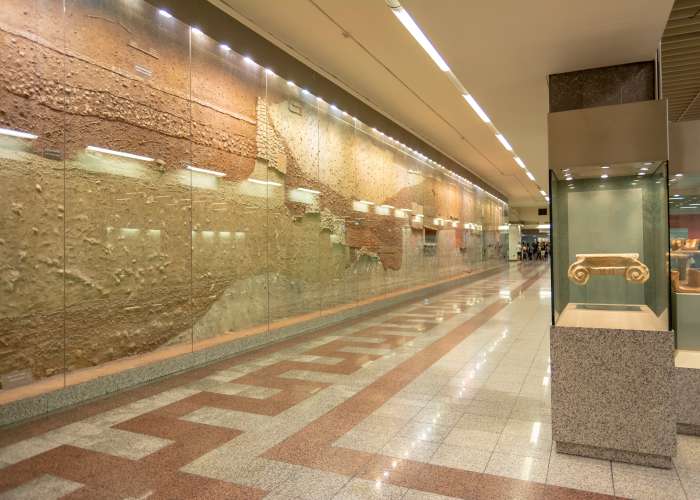
They say talk is cheap, and this is the case, I wholeheartedly agree, as trying to explain the many different ticket prices for the metro would cause more harm than good.
For that reason, I have included below an all-inclusive table that will help you get all the information you need in the most adept way possible!
|
Single Tickets |
|
|
Regular 90-minute single ticket for all public transport means (Airport Metro, Express & X80 bus lines excluded) |
€1,20 |
|
Discount 90-minute single ticket for all public transport means (Airport Metro, Express & X80 bus lines excluded) |
€0,60 |
|
Daily ticket for all public transport means (all Airport transport lines excluded) |
€4,50 |
|
5-day ticket for all public transport means (Airport Metro, Express & X80 bus lines excluded) |
€9,00 |
|
3-day tourist ticket for all public transport means (1 two-way ticket for the Airport included) |
€22,00 |
|
Airport Travel Tickets |
|
|
Regular Athens Metro Airport ticket |
€10,00 |
|
Discount Athens Metro Airport ticket |
€5,00 |
|
2-way Athens Metro Airport ticket |
€18,00 |
|
Regular Athens Metro Airport ticket (from/to Pallini-Kantza-Koropi Metro Stations) |
€6,00 |
|
Discount Athens Metro Airport ticket (from/to Pallini-Kantza-Koropi Metro Stations) |
€3,00 |
|
3-day tourist ticket for all public transport means (1 two-way ticket for the Airport included) |
€22,00 |
For further information on ticket pricing, you can click here.
Who is eligible for reduced-fare tickets?
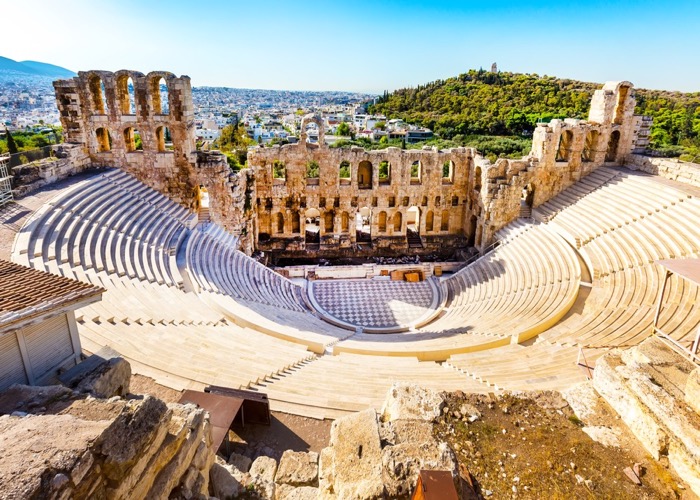
Half-Price or reduced fare tickets can be used by:
Children aged 7-12, regardless of nationality
Teenagers aged 13-18, regardless of nationality, after showing their passport or ID card
Seniors over the age of 65, regardless of nationality, after showing their passport or ID card
Students at public Greek universities and foreign students with an up-to-date student ID from their school who are 24 or younger.
Free travel without a ticket is available for:
Children through the age of 6, regardless of nationality
Athens metro fines

In case of violating the rules and getting fined, you will be given two options for payment. Initially, it is possible to deposit this fine in the Urban rail transport S.A Bank account.
The second option is to pay fines through an Urban Railroad Transport S.A. office or through the Fines Payment Bureau.
The office is at Athens 67 Street 10552, Athens, Greece. You can reach the Fine Payment Office through the mail , or call (212) 214.415.3353. These offices have working hours between 7 a.m. and 4:30 p.m.
How to access the most significant landmarks of Athens by Metro

Thankfully, by using the Metro, you’ll be able to access all of the city's most significant landmarks easily! To make things easier for you, here we’ll show you which line you should follow and at which Metro station you should stop depending on your desired destination.
To reach both Acropolis Hill and the Acropolis Museum, which are located within a couple of minutes' walk from each other, you need to take the line red line -or line 2- and disembark your carriage at the ‘Ácropolis’ Metro station.
Depending on the exit you’ll choose, you’ll be led either outside the Acropolis Museum on the scenic Makrigianni Str. or right across the same street next to the many cafes and taverns of the region. Either will be absolutely fine; you can’t miss the imposing Acropolis even if you want to!
- Syntagma Square
Accessing the most prominent spot of central Athens is expectedly as easy as ABC. All you have to do is take the blue line -or line 3- and disembark your train at the ‘Syntagma’ Metro station. Again, there are two exits you can take.
The one will lead you on Amalias Avenue in front of the Greek Parliament and the Tomb of the Unkown Soldier, while the other one will lead you right to the center of Syntagma Square, right in front of its trademark fountain.
- Monastiraki Square
Last but not least, the green line -or line 1- will take you to the colorful and historic Monastiraki Square! Disembark your train at the homonymous Metro station and explore the fascinating region where Athens’ past and present meet! Its cheerful vibe, impressive monuments, and fun flea market are unquestionably worth your time!
Archaeological excavations found in Athens’ Metro stations
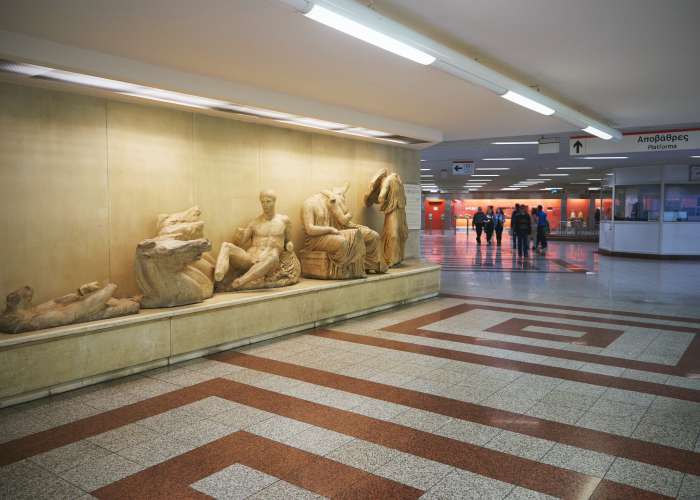
During the multiple years that the construction of Athens’ metro lasted, the excavations that took place brought to light a world of archeological wonder, which can now be admired at every respective Metro station they were found in by the thousands of travelers that use the metro every day.
The most significant archaeological excavations were performed in Athens's four most central metro stations: ‘Syntagma,’ ‘Keramikos,’ ‘Monastiraki,’ and ‘Acropolis.’
Therefore, these stations possess the most impressive collections of archaeological exhibits and offer an excellent way for people to appreciate Athens’ past without having to go out of their way to do so.
‘Syntagma’ Metro station
Inside Syntagma Metro station, the small archaeological exhibition summarizes the main chapters of the town's urban and town-planning history.
Descending from the entrance on the side of the Greek parliament, you can stand in awe before a series of showcases, which host selected archaeological finds from the excavations.
The marble burial monuments inside Syntagma Metro station come from numerous cemeteries; next to them, you can find funeral gifts that accompany the deceased in the afterlife.
Textile weights and amphoras refer to women's occupations and commerce, while a mosaic floor from Roman times reflects the luxurious lifestyle of some residents.
‘Keramikos’ Metro station
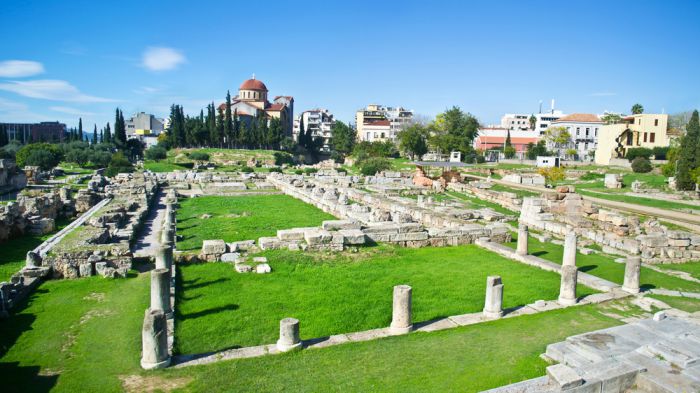
Unlike Syntagma Metro station, Keramikos is, unfortunately, one of the most neglected monuments of central Athens, despite being one of the most striking ones. In antiquity, Kerameikos was named after Keramos -or Ceramus- the son of Dionysios and Ariadne, who discovered the art of pottery and became the patron of potters.
During ancient times, particularly from the 12th century BC and for thousands of years, the area of Kerameikos was used for burials.
It is, therefore, no surprise that the excavations that took place due to the construction of Athens’ metro revealed the most significant cemetery of the ancient world, including 1200 graves dating back to the beginning of the 7th century BC and two burial grounds dating back to the beginning of the Peloponnesian War.
Justifying the area's name, a ceramic art workshop was also brought into the open for people to admire.
‘Monastiraki’ Metro station

Monastiraki, the place where two public transportation lines meet -both the suburban railway and the blue metro line- is one of the oldest stations and was inaugurated in 1890.
The findings revealed continued occupation of the area from the 8th century BC. up until today, while the most important finding that came to light is the riverbed of the Eridanos River that continues to flow beneath the modern city and which passengers can admire right next to the platforms.
‘Acropolis’ station
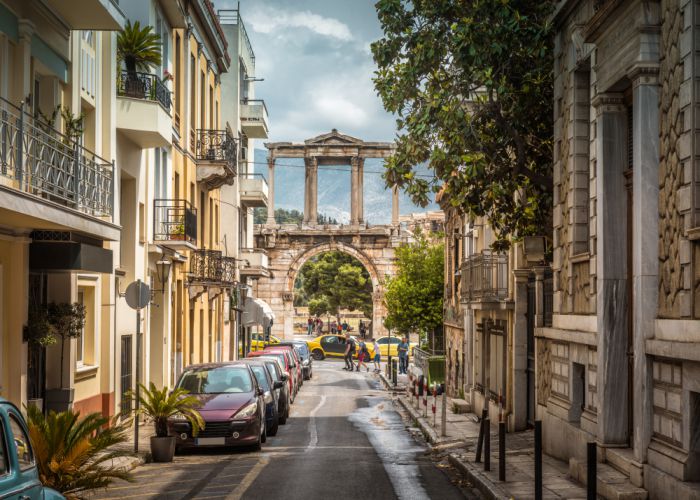
Finally, the Metro station that is most strongly identified with Athens' sights is the Acropolis. The interior of the Metro station houses in its showcases the objects of everyday life of the ancient Athenians found there.
Particularly notable is the copy of the Parthenon frieze displayed on the platforms and copies of the Parthenon’s sculptured gables at the station's entrances.
The placement of the copy of the frieze at such a prominent point was aimed at promoting the Greek demand for the return of the Elgin Marbles from the British Museum to Greece.
By all means, apart from the four central stations, significant discoveries were also made in other stations as well, such as at the Metro station of ‘Evangelismos’ (blue line), where an ancient cemetery with the cemetery surrounding wall and an ancient road were revealed, among others, and the Metro station of ‘Panepistimio’ (red line), where another ancient cemetery was brought to light.
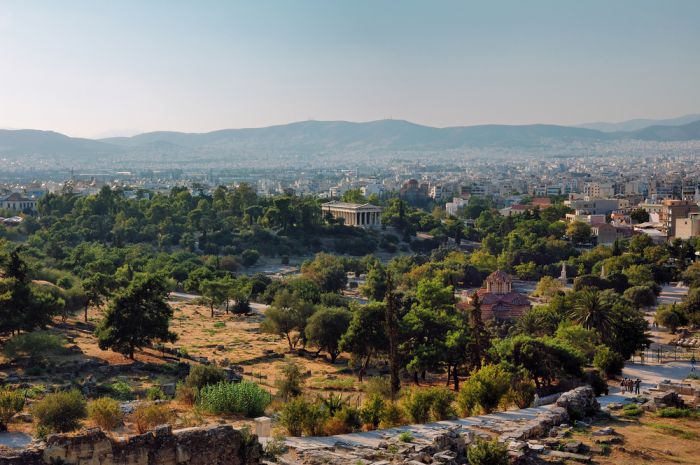
Important relics were also found in the ventilation shafts. Specifically, in the ‘Irodou Attikou’ shaft, a Roman house, a cemetery, and hydraulic systems were discovered; in the ‘Amalias’ Shaft, a Roman bath was encountered; in the ‘Mitropoleos’ shaft, building remains were dug up, and in the ‘Petmeza’ shaft the excavation revealed a classical cemetery.
Additional findings include building ruins dating back to the Roman, Byzantine, and Classical times in ‘Fokionos’ and ‘Thissio’ shafts, workshops and hydraulic systems in the ‘Ermou – Arionos’ shaft, another ancient cemetery in ‘Iachou' shaft, and an important building in the ‘Assomaton’ shaft.
The upcoming fourth line

Almost 30 years after the start of construction of lines 2 and 3 of the Metro, central Athens is preparing to acquire another Metro line.
The much-discussed Metro line 4 will be 13 kilometers long and will include 15 new Metro stations. It will be connected to Metro line 3 at Evangelismos Metro station and to line 2 at Panepistimio Metro station.
The new Metro stations will cover densely populated areas of the city such as Galatsi, Kypseli, Gyzi, low on Alexandras Avenue, Exarchia, Kolonaki, Ilisia, Zografou, and Goudi.
In the future, the line is expected to extend to Maroussi and Lykovrisi via Kifissia Avenue, west to St. Petersburg via Nea Ionia, and south to Ilioupoli via Pagrati.
Final Thoughts

Figuring your way around a foreign city is a daunting task; I get it. However, if you’re visiting Athens, you have nothing to fear!
With the help of an Athens metro map and the modern Athens Metro network, you’ll browse the Greek capital in no time and with little to no effort; it is convenient, it is cheap -significantly cheaper than in any other European country-, and it is everything you wished for, and then some!
Frequently Asked Questions
Is the metro safe in Athens?
Is the Athens metro open 24 hours a day?







